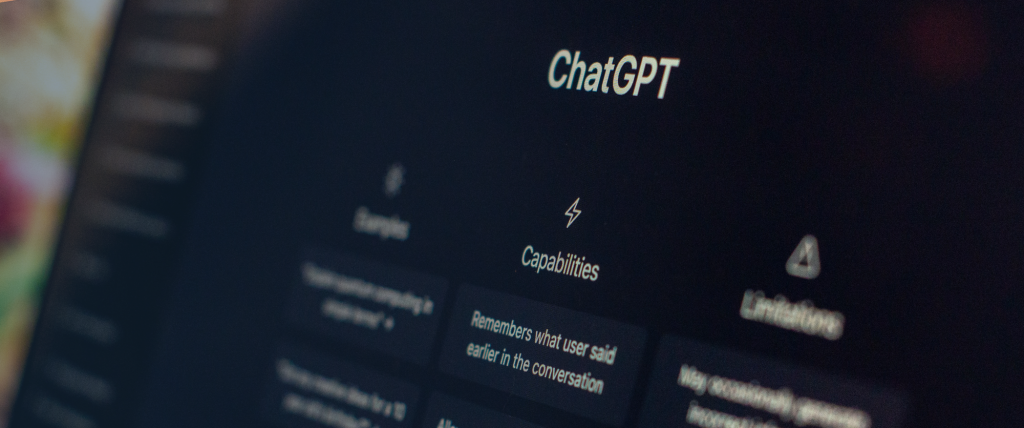Keeping up with the times – seeing the plus side of ChatGPTMaximize visibility and create quality content with AI

It’s probably not escaped you that AI, in all its different forms, is on the rise – especially within the communications sector. We can create photorealistic images, write articles and make music with just a few keystrokes. When ChatGPT launched at the end of November 2022, the impact was so great that even Google was forced to change its perspectives on web content.
News articles and opinion pieces about whether AI will end up taking our jobs are popping up everywhere. But can different AI services – and particularly ChatGPT – replace those of us who work in communications?
While we probably shouldn’t panic just yet, we do need to keep up with technological developments and not fear the advancement of ChatGPT. Above all, we need to learn how to work with it, so we don’t get left behind by those who have already realised its benefits.
Before and after the launch of ChatGPT
Before ChatGPT launched, Google released an update called Helpful Content. It stated that all texts should be written by people, for people, and not for search engines. It also said that Google is increasingly focusing on genuine content, and that they value content that is new and unique. For high visibility on Google, we should include these criteria.
Read more about Helpful Content here.
Jump back to November 2022, when the launch of ChatGPT made the whole world wonder what the future might look like. Will those of us working in the communications sector be outcompeted by AI? Not exactly, but there is a risk that we will be outcompeted by those who learn how to manage and work with AI. This is because different AI services, perhaps most of all ChatGPT, are helpful tools for producing content and can be very beneficial to our work with SEO.
ChatGPT is a chatbot – or virtual assistant – that can answer questions through responding to various kinds of prompts. It can, for example, provide information depending on what we ask it, help us write texts and provide suggestions for SEO. The better the prompts we learn to write, the more useful answers we will get.
Google EEAT
Back to Google and its update that came in the wake of ChatGPT’s launch. Google EAT, which stands for Expertise, Authoritativeness and Trustworthiness, now has another E tacked on – for Experience. EEAT is a concept that describes Google’s viewpoint, how it understands the content of our websites and decides where that content will end up in its search results. Content that ranks high on Google offers a lot of knowledge and benefit for users and is written by experts within the field. Other factors include an authenticity and credibility resulting from the content being discussed or receiving positive feedback from other sources, as well as demonstrable, first-hand experience with the subject. In connection with the update, Google stated that it is acceptable to create content with the help of AI. However, can ChatGPT alone create content that fulfils all the parameters that EEAT stands for?
What’s unique about humans is that we have experiences, opinions, feelings and the ability to create new content – things Google values highly in terms of SEO. ChatGPT, on the other hand, gathers content from existing texts and lacks the ability to fact-check or draw on personal experiences – things we humans can benefit from when creating content. This is particularly relevant for companies that wish to differentiate themselves from the masses of exiting content and rank high in Google’s search results.
Content creation and SEO with ChatGPT
Because ChatGPT can produce texts for many different purposes, the launch of ChatGPT made it easier for people in the communications sector to rapidly put out content. Suddenly we could get help writing copy or summaries, translating texts and creating presentations.
ChatGPT is also a good tool for SEO. It can help us by quickly providing keywords within different subjects and based on our texts. It can also help with categorising keywords and suggesting ideas for titles, links and meta descriptions. That said, the more it is used, the higher the bar for what constitutes good content will rise.
Considering this, and the previously mentioned disadvantages of ChatGPT, we can’t just let it do our jobs for us. For those of us who want to create quality content with the concept of EEAT in the back of our minds, it is necessary to have a good understanding of how ChatGPT functions and how the tool can be used for streamlining and optimisation. ChatGPT can help us be more productive, eliminate parts of our preliminary work, and give us good ideas. It can deliver a decent first draft, but if we want to create content that shines on the web, we need to add our expertise, opinions and experiences.
Reap the benefits
In summary, we can’t ignore the fact that various AI services – especially ChatGPT – are penetrating the communications industry. There are many advantages if we learn to work with these tools, partly in terms of producing content and partly in terms of work-time efficiency. In March 2023, CNN reported that within a few months we will be able to instruct a virtual assistant to take meeting notes and turn Word documents into PowerPoint presentations. There is a lot to benefit from.
We don’t need to worry about AI suddenly taking over our jobs just yet. That said, there is a risk of being outcompeted by those who keep up and already benefit from all the advantages that AI brings. So, take heart. Try and learn to work together with different AI tools to deliver quality-assured, SEO-adapted content at a consistently high level.
Let’s end with another advantage for those who aren’t afraid of AI, recently summed up by Microsoft CEO Satya Nadella:
We believe this next generation of AI will unlock a new wave of productivity growth: powerful co-pilots designed to remove the drudgery from our daily tasks and jobs, freeing us to rediscover the joy of creation.”
Author: Hanna Virdhall
Sources:
Curious to know more? Contact me.
